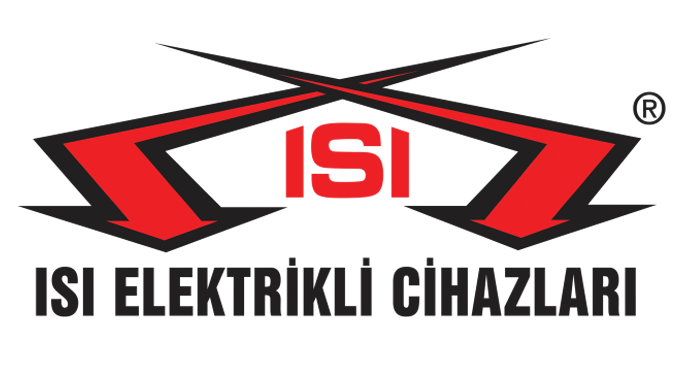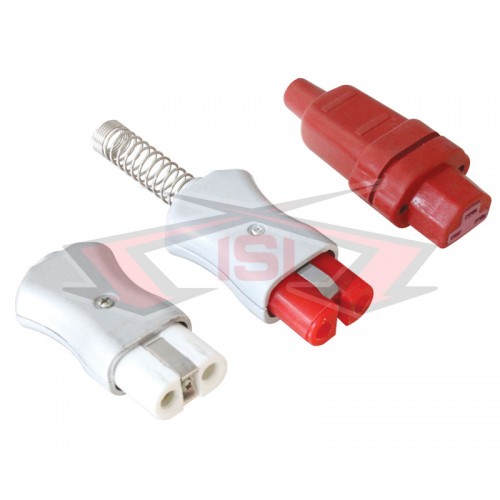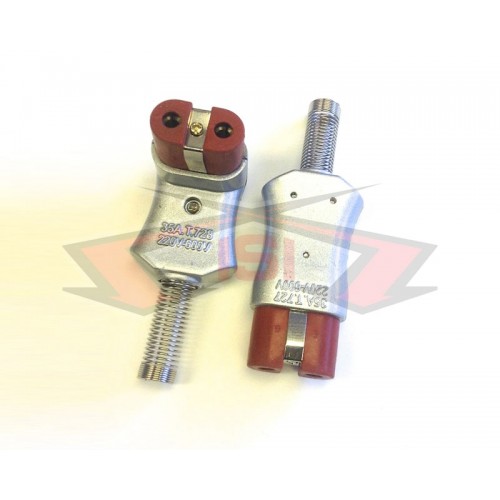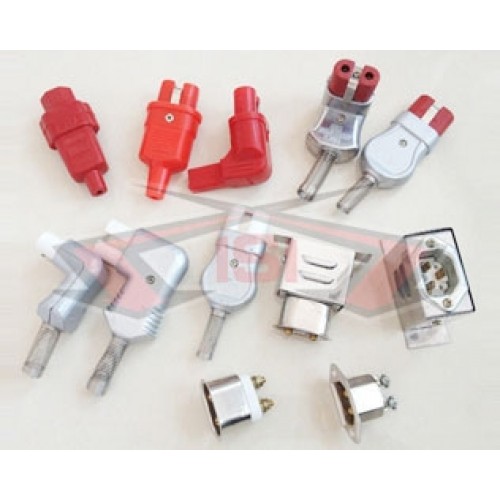Plugs & Sockets
Heat Resistant Fasteners are used in electrical supply connections of industrial heaters, generally plastic injection machine resistances, at points exposed to high temperatures. Silicone body models can be used up to a maximum of 300 degrees, ceramic body models can be used up to a maximum of 400 degrees.
Plugs & Outlets
Plugs and outlets are fundamental components for the transmission and utilization of electric current. While a plug is used to connect an electrical device to a power source, an outlet is used to transmit electric energy to the device. This is a system widely used in all kinds of electrical devices, from household appliances to industrial equipment.
The Role of Resistors in Plugs and Sockets
Resistors are essential components commonly used in electrical devices. They are primarily used to convert electrical energy into heat energy. Many electrical devices rely on resistors for heating purposes, including water heaters, electric stoves, heating ovens, irons, hair dryers, coffee machines, and industrial heaters.
Working Principle of Resistors:
Resistors generate heat by resisting the flow of electrical current. This process is known as the Joule effect. As electricity flows through a high-resistance wire or plate, the movement of electrons produces heat. This allows electrical energy to be directly converted into thermal energy for various heating applications.
The Role of Plugs and Sockets:
Plugs and sockets are fundamental connection elements that ensure the safe transmission of electrical energy. They allow electrical devices to be connected to a power source, helping to regulate energy flow. The quality of plugs and sockets is crucial for safety. Poor connections or inadequate insulation can lead to electrical leaks or overheating.
Relationship Between Resistors, Plugs, and Sockets:
- Power Transmission: While resistors generate heat using electrical energy, plugs and sockets ensure the safe transmission of this energy.
- Safety: High-quality materials and well-insulated plugs are essential to prevent overheating in sockets.
- Efficient Operation: Plugs and sockets provide a stable electrical current, allowing resistors to function reliably.
- Industrial Applications: In large-scale heating systems, plugs and sockets must have high current capacities. Industrial-grade plugs and sockets are specifically designed for high-power requirements.
Key Considerations When Using Plugs and Sockets:
- Regularly inspect electrical devices’ plugs and sockets. Replace damaged or worn-out plugs.
- Avoid overloading sockets. Running too many devices on the same socket can lead to overheating.
- Ensure that plugs and sockets used for high-power devices have the appropriate amperage.
- Use additional insulation and protection for sockets in wet or humid environments.
Resistors, plugs, and sockets are directly interconnected components. Proper selection and regular maintenance not only extend the lifespan of devices but also ensure safe usage.
Applications of Heater Outlets
- Refrigerators and Freezers: Refrigerators and freezers can be equipped with heater outlets along with thermostats to regulate the temperature inside. This ensures that the temperature inside is maintained within a certain range.
- Aquariums: Fish tanks and aquariums are sensitive environments that need to be maintained within a specific temperature range. Heater outlets can be used in conjunction with aquarium heaters to keep the water temperature at the desired level.
- Greenhouses and Plant Nurseries: Greenhouses and plant nurseries require control over factors like temperature and humidity. Heater outlets can be used to control heating systems as well as humidifiers and coolers.
- Animal Heating Equipment: Heating lamps or heating pads used for poultry or pets, for instance, need to be maintained at a certain temperature. Heater outlets can ensure that such equipment operates safely and effectively.
- Greenhouse Heating Systems: Large-scale greenhouse operations require complex heating systems to optimize plant growing conditions. Heater outlets can be used to control the components of greenhouse heating systems.
Energy Efficiency of Resistance Plugs
Resistance plugs are a special type of plug designed to enhance energy efficiency and prevent energy waste. These plugs help reduce unnecessary power consumption in electrical devices, making them useful in both household and industrial applications.
Working Principle of Resistance Plugs:
Resistance plugs are equipped with mechanisms that control electricity consumption in devices. They typically include a switch or a timer system that automatically disables the plug after a certain period, preventing unnecessary energy usage.
For example:
- Manual Switch Models: Users can manually turn the device on and off, preventing unnecessary operation.
- Timer-Based Models: The device automatically shuts off after a preset period, reducing energy consumption.
- Smart Plug Models: Equipped with Wi-Fi or Bluetooth connectivity, these plugs can be controlled via mobile applications for optimal energy management.
Advantages of Resistance Plugs:
- Energy Savings: Reduces unnecessary power consumption, lowering electricity bills.
- Safety: Prevents devices from running for extended periods, reducing the risk of fire and overheating.
- Eco-Friendly: Helps promote environmental sustainability by reducing energy usage.
- Ease of Use: Designed with user-friendly manual or automatic control mechanisms.
Applications:
- Home Use: Ideal for high-energy-consuming appliances such as heaters, irons, and water heaters.
- Office Environments: Used for managing the power supply of computers, printers, and other electronic devices.
- Industry and Factories: Helps regulate the operation of large machinery for controlled power usage.
Resistance plugs are an excellent solution for individuals and businesses looking to improve energy efficiency. Selecting the right plug model is crucial for optimizing electricity consumption and preventing energy waste.
Features of Plugs & Sockets That Provide High Thermal Efficiency
Plugs and sockets used in electrical systems play a crucial role in enhancing energy efficiency. Especially those designed with high heat resistance and minimal energy loss offer both safe and efficient usage.
Key Features That Ensure High Thermal Efficiency:
- High Heat Resistance: Specially designed plugs and sockets are made from heat-resistant materials to minimize the risk of overheating.
- Low-Resistance Conductors: Materials such as copper and silver coatings enhance conductivity, reducing energy loss and ensuring efficient current flow.
- Heat-Distributing Design: Designs that evenly distribute heat prevent excessive heating, providing long-lasting performance.
- Insulation Materials: Heat- and electricity-resistant ceramic or flame-retardant plastic materials enhance safety while maintaining energy efficiency.
- Smart Socket Systems: Smart sockets with automatic shut-off features prevent unnecessary energy consumption and protect devices from overheating.
Advantages of Using Energy-Efficient Plugs & Sockets:
- Electricity Savings: Low-resistance connections help minimize electricity losses.
- Longer Lifespan: Special materials that prevent overheating extend the lifespan of plugs and sockets.
- Reduced Fire Risk: Heat-resistant materials and balanced heat distribution minimize fire hazards.
- Protection for Electrical Devices: Stable current transmission and proper heat dissipation ensure the safe operation of electronic devices.
Plugs and socket systems that provide high thermal efficiency offer both safe and energy-friendly solutions, bringing significant advantages in daily life and industrial applications.
Technical Details of Plugs & Sockets
Plugs and sockets are essential components in electrical systems that ensure safe and efficient power transmission. They are designed to meet various needs in residential, commercial, and industrial applications with different designs, materials, and technical specifications.
Key Technical Details of Plugs & Sockets:
- Voltage and Current Ratings: Plugs and sockets are designed to support different voltage levels (e.g., 110V, 220V, 380V) and current capacities (e.g., 10A, 16A, 32A). Selecting the correct type ensures safe usage and prevents overload.
- Material Composition: High-quality materials such as copper conductors and flame-retardant plastic or ceramic improve conductivity and safety.
- Pin Configuration: Two-pin (Type A, C) or three-pin (Type B, E, F) plug designs provide compatibility with various socket types and grounding requirements.
- Grounding Mechanism: Many sockets include grounding features to enhance safety and prevent electric shocks, particularly in high-power applications.
- Insulation and Protection: Proper insulation materials offer protection against electrical hazards, while IP-rated waterproof sockets are suitable for outdoor or industrial environments.
- Smart Features: Modern sockets may include USB ports, surge protection, Wi-Fi connectivity, and intelligent control functions.
Types of Plugs & Sockets:
- Standard Household Plugs: Commonly used in homes to power daily appliances such as televisions, lamps, and kitchen devices.
- Industrial-Grade Sockets: Designed for high-power equipment, these sockets have reinforced insulation and higher amperage ratings.
- Outdoor Sockets: Waterproof and dustproof sockets (IP44, IP67) suitable for outdoor or humid environments.
- Smart Sockets: Equipped with Wi-Fi or Bluetooth connectivity, these sockets allow remote control and energy monitoring.
Understanding the technical details of plugs and sockets is crucial for selecting the right components to ensure safe, efficient, and long-lasting electrical systems.
Saving Energy with Plugs & Sockets
Today, energy conservation is crucial for both environmental sustainability and economic benefits. Using the right plugs and sockets effectively helps prevent unnecessary energy consumption and contributes to energy savings.
Features That Promote Energy Savings:
- Smart Sockets: Wi-Fi-enabled smart sockets allow remote control of devices and automatically turn them off when not in use.
- Power Cut-Off Feature: Energy-efficient sockets automatically cut off power when connected devices are not in use, preventing unnecessary electricity consumption.
- Timed Sockets: Devices can be programmed to operate only during specific hours, reducing unnecessary energy usage.
- Overcurrent Protection: Sockets with overcurrent protection detect devices that draw excessive energy and regulate the power flow for both efficiency and safety.
- Low Consumption Materials: High-quality copper conductors and insulated materials minimize energy loss in sockets.
Tips for Saving Energy:
- Instead of leaving electronic devices in standby mode, turn them off completely or use smart sockets to cut off power.
- Opt for low-energy-consuming appliances and use them with energy-efficient sockets.
- Regularly check for unnecessary lighting and electronic devices left on.
- For outdoor use, choose energy-efficient and weather-resistant sockets.
Using plugs and sockets wisely not only reduces your electricity bills but also minimizes your environmental impact. By integrating smart technologies, you can make energy conservation a part of your daily life.
Technical Details to Consider When Choosing Plugs & Sockets
Choosing the right plugs and sockets is crucial for safety, durability, and energy efficiency in electrical systems. Incorrect selections can lead to power losses, device failures, and even fire hazards. Therefore, the following technical details should be considered when selecting plugs and sockets.
1. Power and Current Capacity
- The maximum current capacity of plugs and sockets (e.g., 10A, 16A) should match the device requirements.
- The voltage compatibility of plugs and sockets should be checked (e.g., 220V, 380V).
2. Material Quality
- High-quality copper conductors provide low resistance and reduce energy loss.
- Flame-retardant plastic or ceramic materials minimize fire hazards.
3. Grounding and Safety
- Grounded sockets offer extra protection against electrical leaks.
- Child-proof socket covers enhance safety, especially in homes and offices.
4. Suitability for Usage Area
- Outdoor sockets should be resistant to water and dust (IP44, IP65 protection ratings).
- Heavy-duty sockets should be durable and impact-resistant for high-use areas.
5. Smart Technology Options
- Wi-Fi-enabled smart sockets allow remote control and energy savings.
- Timer sockets help prevent unnecessary energy consumption by switching devices on and off at set times.
Paying attention to these technical details when choosing plugs and sockets ensures safer and more efficient electricity usage while extending the lifespan of your devices.
Working Principle of Plugs & Sockets
Plugs and sockets are fundamental electrical components that ensure the safe transmission of electrical current. These systems enable the transfer of electrical energy to devices, making it possible for many electronic devices to function in daily life.
1. Transmission of Electrical Current
- The plug is the component that connects an electrical device to a power source.
- The socket receives power from the electrical grid and transfers it to devices via the plug.
- The metal prongs of the plug make contact with the conductive parts of the socket, completing the circuit and allowing current to flow.
2. Phase, Neutral, and Ground Wires
- Electrical current typically flows through two main lines: the phase and neutral wires.
- The phase wire carries the electrical current.
- The neutral wire completes the circuit and returns the current.
- The ground wire protects devices from overvoltage and leakage currents.
3. Safety Mechanisms
- Modern sockets may include child safety covers to prevent small objects from being inserted.
- Fused and surge-protected sockets safeguard devices against electrical fluctuations.
- Grounded plugs and sockets prevent electric leaks from harming users.
4. Cutting Off the Current
- When the plug is removed from the socket, the electrical connection is interrupted, stopping the current flow.
- Some sockets include an on/off switch, allowing the power to be cut off without unplugging the device.
Plugs and sockets are manufactured according to specific standards to ensure safe electricity transmission and play a crucial role in our daily lives.
Frequently Asked Questions
Plugs & Sockets



